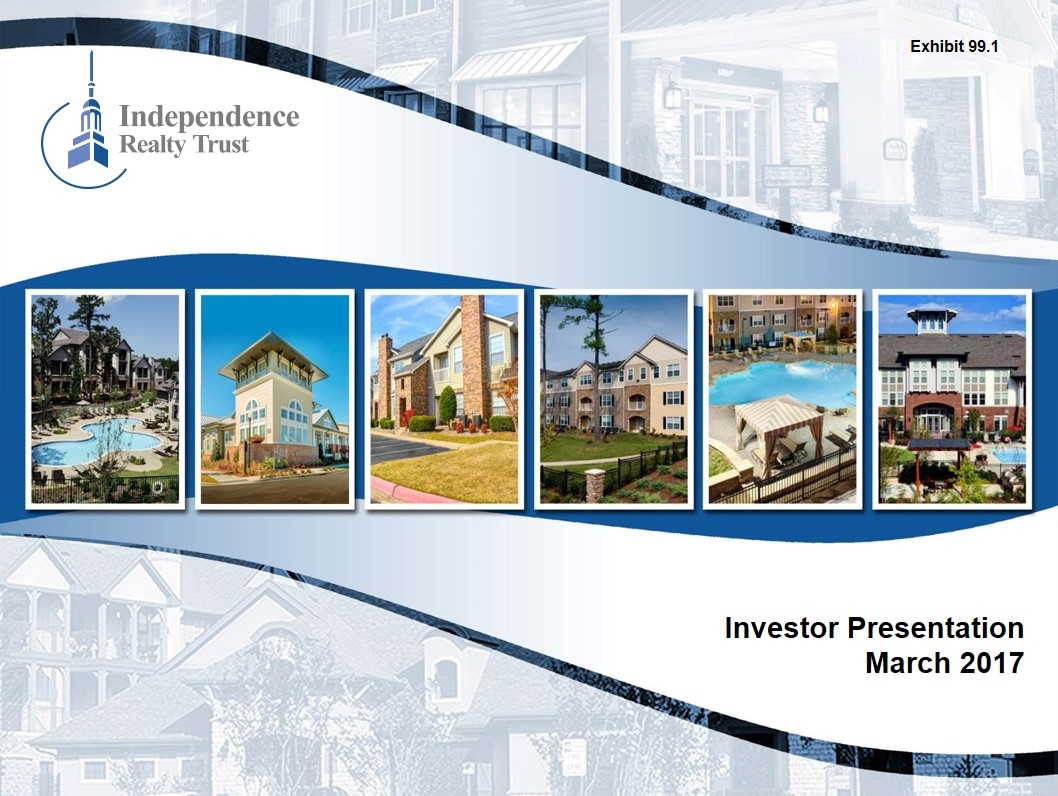
2.60 1.80 2.15 3.30 3.75 5.10 0.15 5.10 4.50 - logo 0.15 Investor Presentation March 2017 0 34 84 18 86 154 108 134 195 82 89 95 191 191 191 241 229 24 33 75 35 255 175 25 Exhibit 99.1
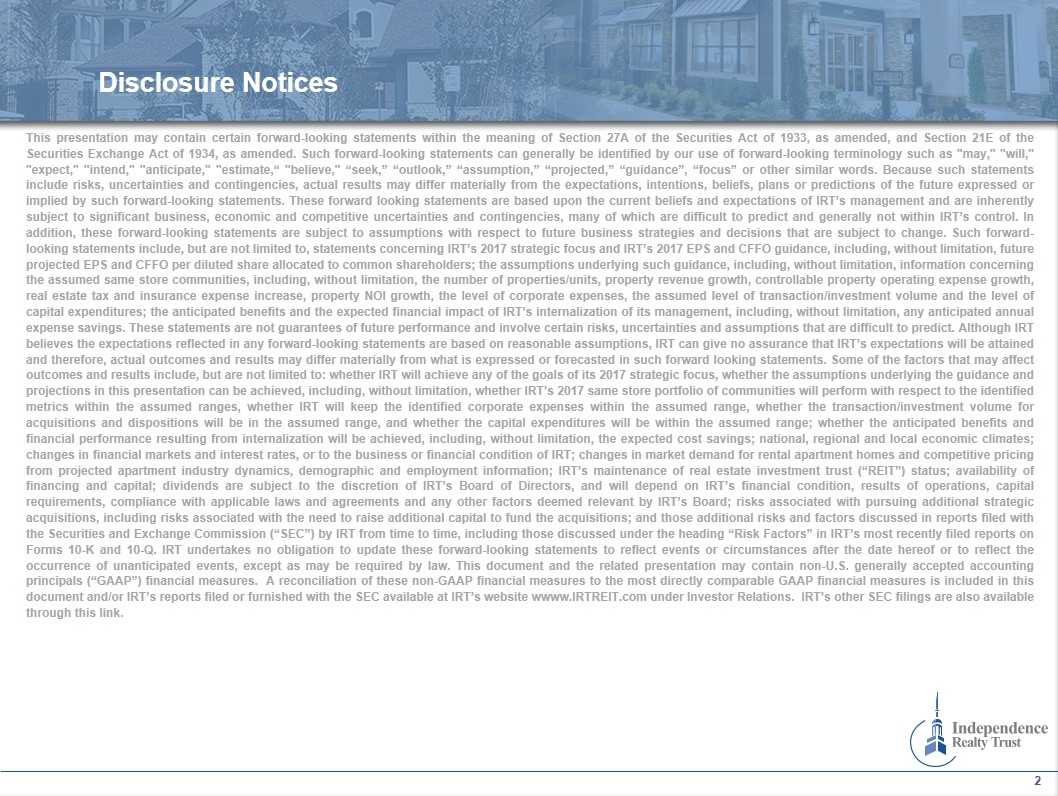
This presentation may contain certain forward-looking statements within the meaning of Section 27A of the Securities Act of 1933, as amended, and Section 21E of the Securities Exchange Act of 1934, as amended. Such forward-looking statements can generally be identified by our use of forward-looking terminology such as "may," "will," "expect," "intend," "anticipate," "estimate,“ "believe," “seek,” “outlook,” “assumption,” “projected,” “guidance”, “focus” or other similar words. Because such statements include risks, uncertainties and contingencies, actual results may differ materially from the expectations, intentions, beliefs, plans or predictions of the future expressed or implied by such forward-looking statements. These forward looking statements are based upon the current beliefs and expectations of IRT’s management and are inherently subject to significant business, economic and competitive uncertainties and contingencies, many of which are difficult to predict and generally not within IRT’s control. In addition, these forward-looking statements are subject to assumptions with respect to future business strategies and decisions that are subject to change. Such forward-looking statements include, but are not limited to, statements concerning IRT’s 2017 strategic focus and IRT’s 2017 EPS and CFFO guidance, including, without limitation, future projected EPS and CFFO per diluted share allocated to common shareholders; the assumptions underlying such guidance, including, without limitation, information concerning the assumed same store communities, including, without limitation, the number of properties/units, property revenue growth, controllable property operating expense growth, real estate tax and insurance expense increase, property NOI growth, the level of corporate expenses, the assumed level of transaction/investment volume and the level of capital expenditures; the anticipated benefits and the expected financial impact of IRT’s internalization of its management, including, without limitation, any anticipated annual expense savings. These statements are not guarantees of future performance and involve certain risks, uncertainties and assumptions that are difficult to predict. Although IRT believes the expectations reflected in any forward-looking statements are based on reasonable assumptions, IRT can give no assurance that IRT’s expectations will be attained and therefore, actual outcomes and results may differ materially from what is expressed or forecasted in such forward looking statements. Some of the factors that may affect outcomes and results include, but are not limited to: whether IRT will achieve any of the goals of its 2017 strategic focus, whether the assumptions underlying the guidance and projections in this presentation can be achieved, including, without limitation, whether IRT’s 2017 same store portfolio of communities will perform with respect to the identified metrics within the assumed ranges, whether IRT will keep the identified corporate expenses within the assumed range, whether the transaction/investment volume for acquisitions and dispositions will be in the assumed range, and whether the capital expenditures will be within the assumed range; whether the anticipated benefits and financial performance resulting from internalization will be achieved, including, without limitation, the expected cost savings; national, regional and local economic climates; changes in financial markets and interest rates, or to the business or financial condition of IRT; changes in market demand for rental apartment homes and competitive pricing from projected apartment industry dynamics, demographic and employment information; IRT’s maintenance of real estate investment trust (“REIT”) status; availability of financing and capital; dividends are subject to the discretion of IRT’s Board of Directors, and will depend on IRT’s financial condition, results of operations, capital requirements, compliance with applicable laws and agreements and any other factors deemed relevant by IRT’s Board; risks associated with pursuing additional strategic acquisitions, including risks associated with the need to raise additional capital to fund the acquisitions; and those additional risks and factors discussed in reports filed with the Securities and Exchange Commission (“SEC”) by IRT from time to time, including those discussed under the heading “Risk Factors” in IRT’s most recently filed reports on Forms 10-K and 10-Q. IRT undertakes no obligation to update these forward-looking statements to reflect events or circumstances after the date hereof or to reflect the occurrence of unanticipated events, except as may be required by law. This document and the related presentation may contain non-U.S. generally accepted accounting principals (“GAAP”) financial measures. A reconciliation of these non-GAAP financial measures to the most directly comparable GAAP financial measures is included in this document and/or IRT’s reports filed or furnished with the SEC available at IRT’s website wwww.IRTREIT.com under Investor Relations. IRT’s other SEC filings are also available through this link. Disclosure Notices
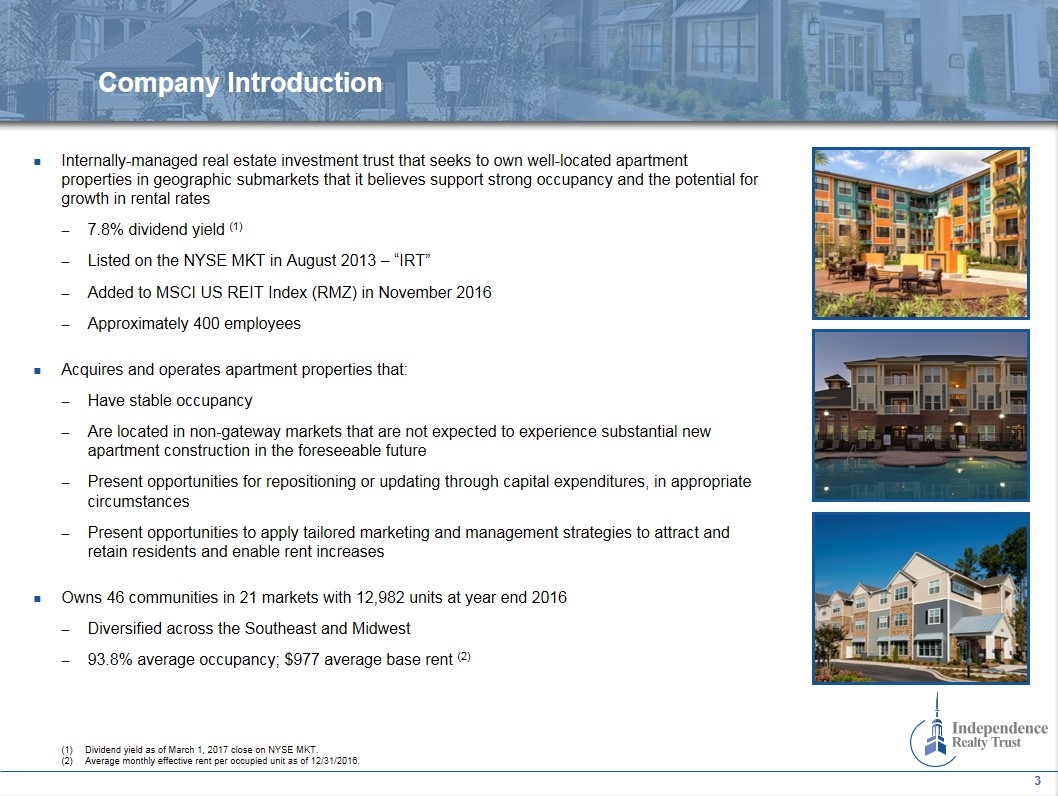
Internally-managed real estate investment trust that seeks to own well-located apartment properties in geographic submarkets that it believes support strong occupancy and the potential for growth in rental rates 7.8% dividend yield (1) Listed on the NYSE MKT in August 2013 – “IRT” Added to MSCI US REIT Index (RMZ) in November 2016 Approximately 400 employees Acquires and operates apartment properties that: Have stable occupancy Are located in non-gateway markets that are not expected to experience substantial new apartment construction in the foreseeable future Present opportunities for repositioning or updating through capital expenditures, in appropriate circumstances Present opportunities to apply tailored marketing and management strategies to attract and retain residents and enable rent increases Owns 46 communities in 21 markets with 12,982 units at year end 2016 Diversified across the Southeast and Midwest 93.8% average occupancy; $977 average base rent (2) Company Introduction Dividend yield as of March 1, 2017 close on NYSE MKT. Average monthly effective rent per occupied unit as of 12/31/2016.
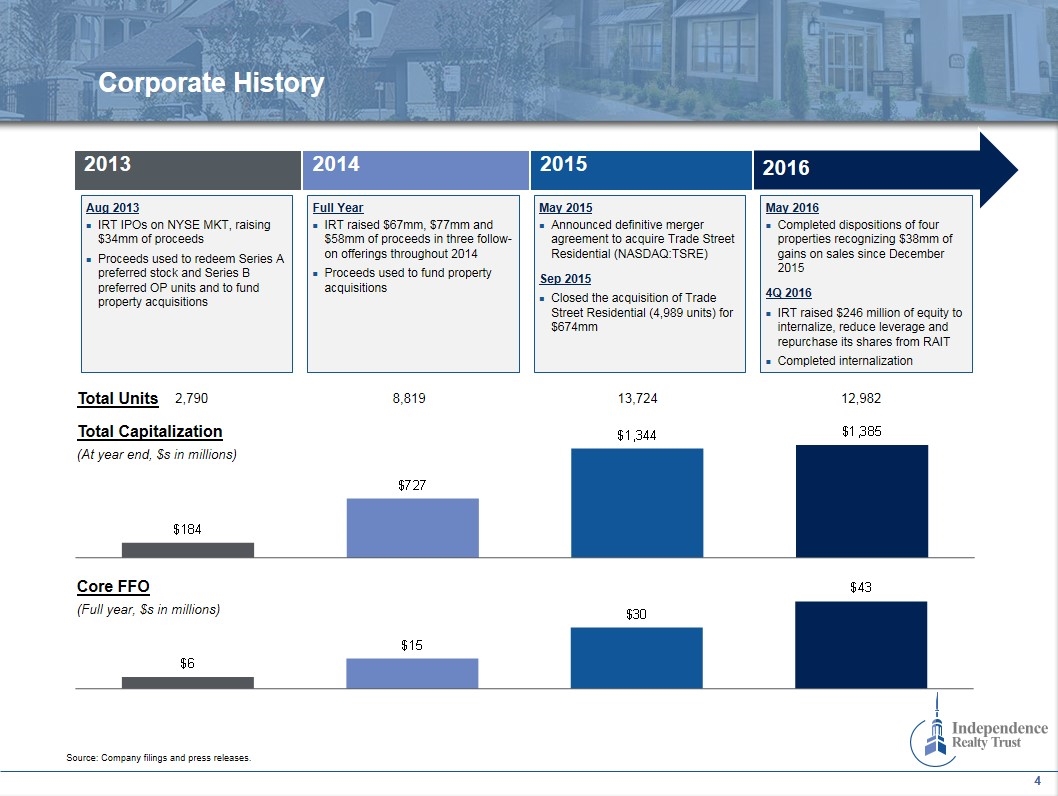
Total Units Corporate History 2013 2014 2015 2016 Aug 2013 IRT IPOs on NYSE MKT, raising $34mm of proceeds Proceeds used to redeem Series A preferred stock and Series B preferred OP units and to fund property acquisitions Full Year IRT raised $67mm, $77mm and $58mm of proceeds in three follow-on offerings throughout 2014 Proceeds used to fund property acquisitions May 2015 Announced definitive merger agreement to acquire Trade Street Residential (NASDAQ:TSRE) Sep 2015 Closed the acquisition of Trade Street Residential (4,989 units) for $674mm May 2016 Completed dispositions of four properties recognizing $38mm of gains on sales since December 2015 4Q 2016 IRT raised $246 million of equity to internalize, reduce leverage and repurchase its shares from RAIT Completed internalization 2,790 8,819 13,724 12,982 Total Capitalization (At year end, $s in millions) Core FFO (Full year, $s in millions) Source: Company filings and press releases.
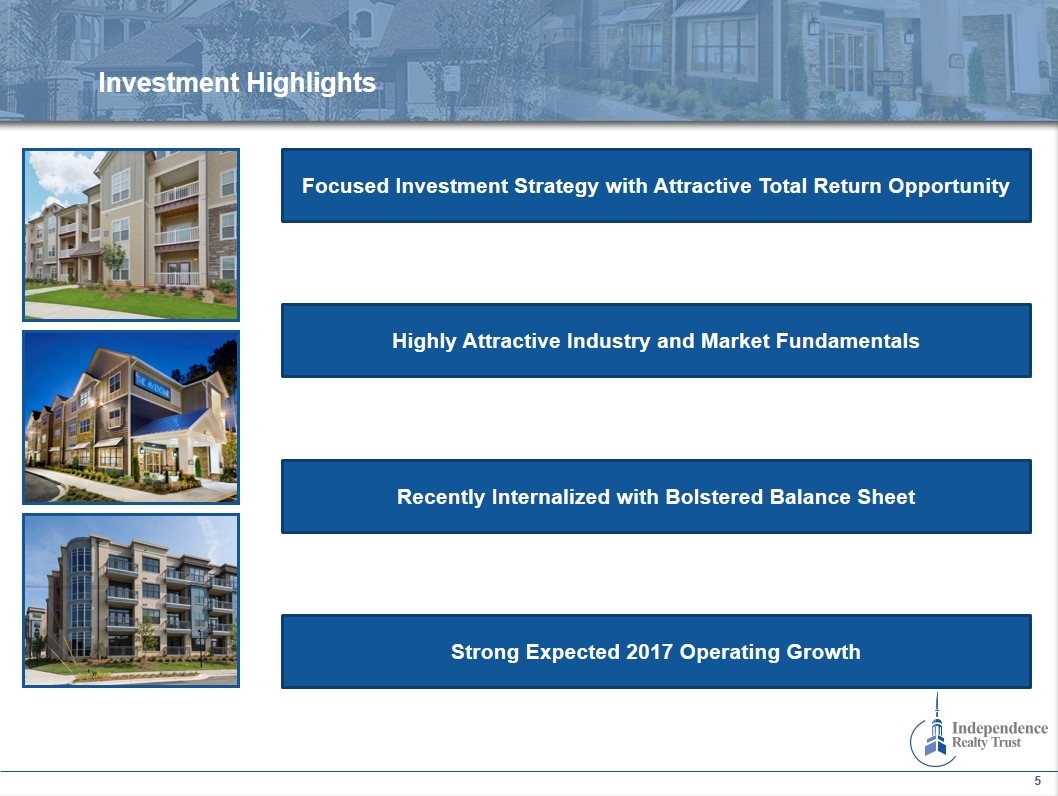
Recently Internalized with Bolstered Balance Sheet Focused Investment Strategy with Attractive Total Return Opportunity Strong Expected 2017 Operating Growth Investment Highlights Highly Attractive Industry and Market Fundamentals
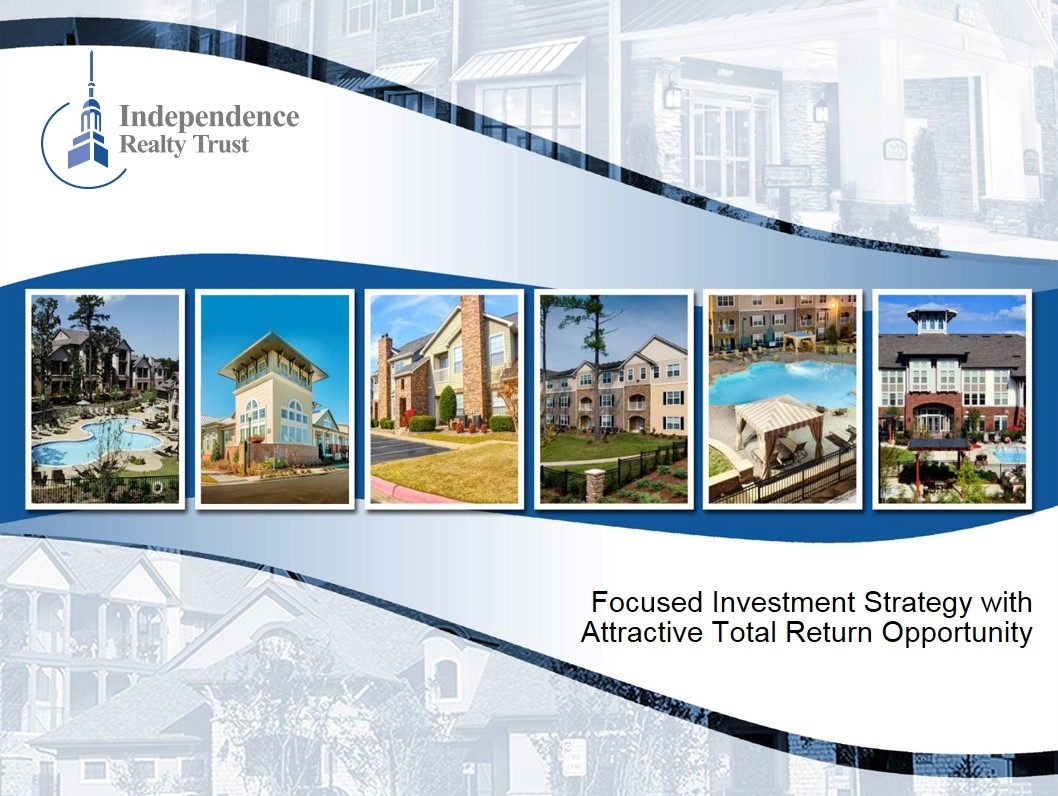
2.60 1.80 2.15 3.30 3.75 5.10 0.15 5.10 4.50 - logo 0.15 Focused Investment Strategy with Attractive Total Return Opportunity
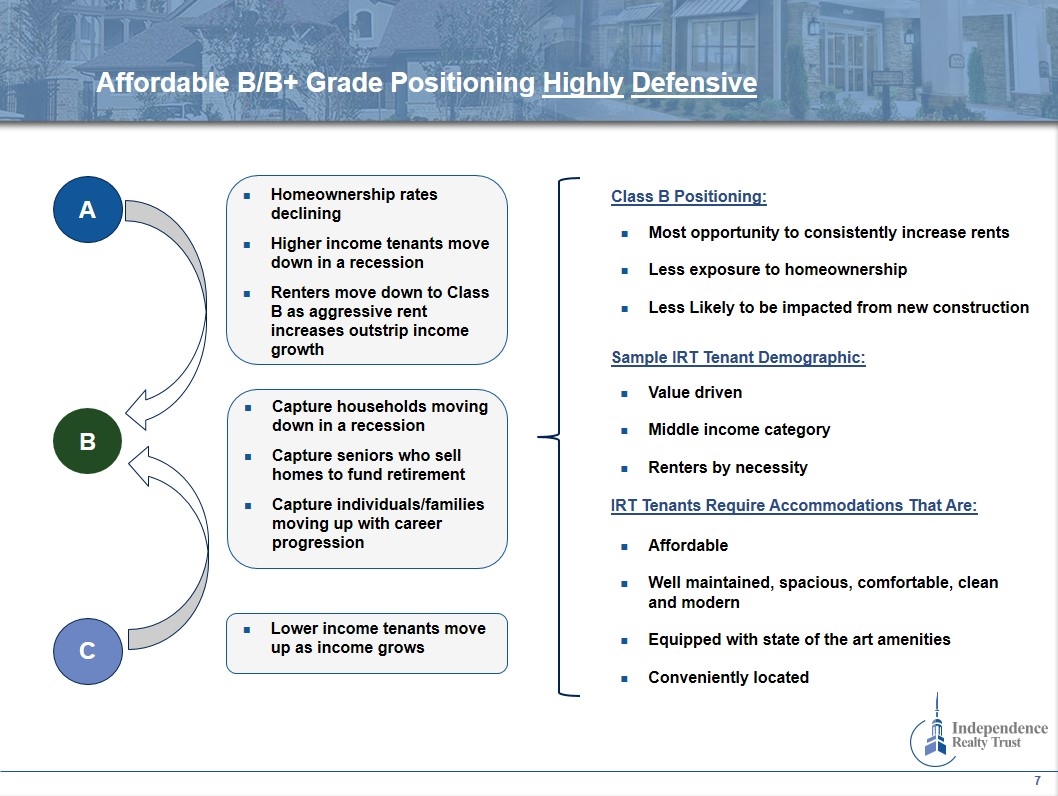
Affordable B/B+ Grade Positioning Highly Defensive A B C Homeownership rates declining Higher income tenants move down in a recession Renters move down to Class B as aggressive rent increases outstrip income growth Capture households moving down in a recession Capture seniors who sell homes to fund retirement Capture individuals/families moving up with career progression Lower income tenants move up as income grows Sample IRT Tenant Demographic: Value driven Middle income category Renters by necessity IRT Tenants Require Accommodations That Are: Affordable Well maintained, spacious, comfortable, clean and modern Equipped with state of the art amenities Conveniently located Class B Positioning: Most opportunity to consistently increase rents Less exposure to homeownership Less Likely to be impacted from new construction
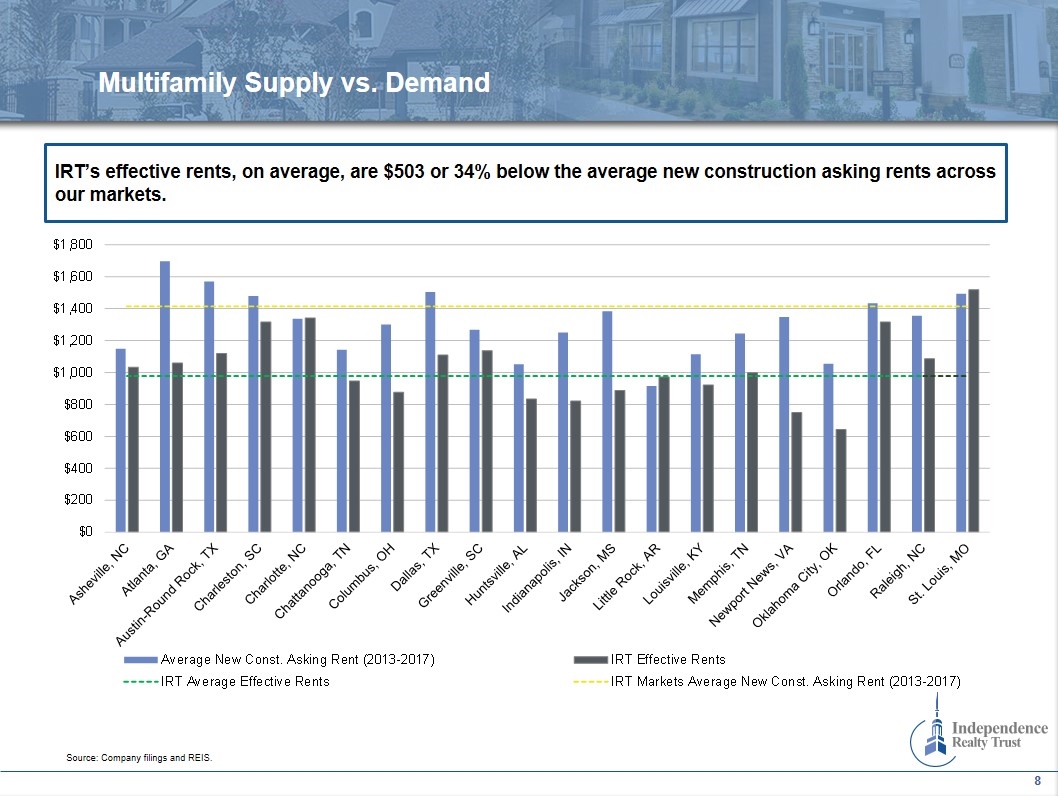
Multifamily Supply vs. Demand IRT’s effective rents, on average, are $503 or 34% below the average new construction asking rents across our markets. Source: Company filings and REIS.
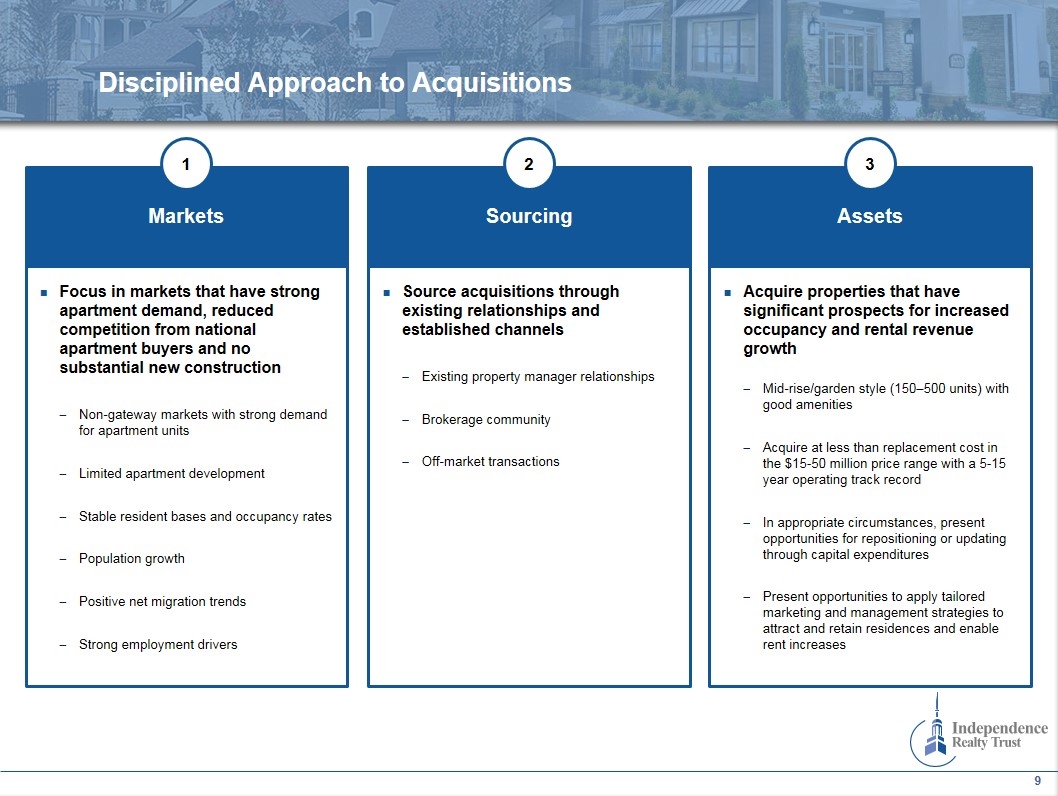
Sourcing Disciplined Approach to Acquisitions 2 Assets 3 Acquire properties that have significant prospects for increased occupancy and rental revenue growth Mid-rise/garden style (150–500 units) with good amenities Acquire at less than replacement cost in the $15-50 million price range with a 5-15 year operating track record In appropriate circumstances, present opportunities for repositioning or updating through capital expenditures Present opportunities to apply tailored marketing and management strategies to attract and retain residences and enable rent increases Source acquisitions through existing relationships and established channels Existing property manager relationships Brokerage community Off-market transactions Markets 1 Focus in markets that have strong apartment demand, reduced competition from national apartment buyers and no substantial new construction Non-gateway markets with strong demand for apartment units Limited apartment development Stable resident bases and occupancy rates Population growth Positive net migration trends Strong employment drivers
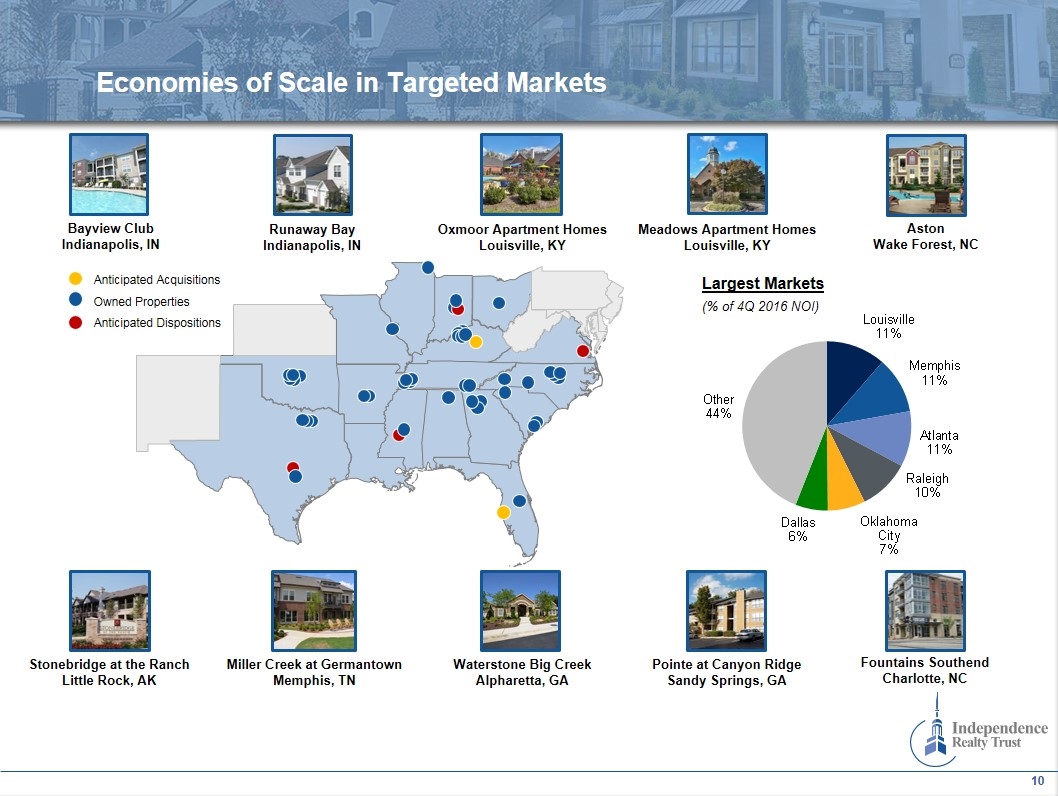
Economies of Scale in Targeted Markets Runaway Bay Indianapolis, IN Oxmoor Apartment Homes Louisville, KY Bayview Club Indianapolis, IN Meadows Apartment Homes Louisville, KY Stonebridge at the Ranch Little Rock, AK Pointe at Canyon Ridge Sandy Springs, GA Waterstone Big Creek Alpharetta, GA Miller Creek at Germantown Memphis, TN Aston Wake Forest, NC Fountains Southend Charlotte, NC Largest Markets (% of 4Q 2016 NOI) Anticipated Acquisitions Owned Properties Anticipated Dispositions
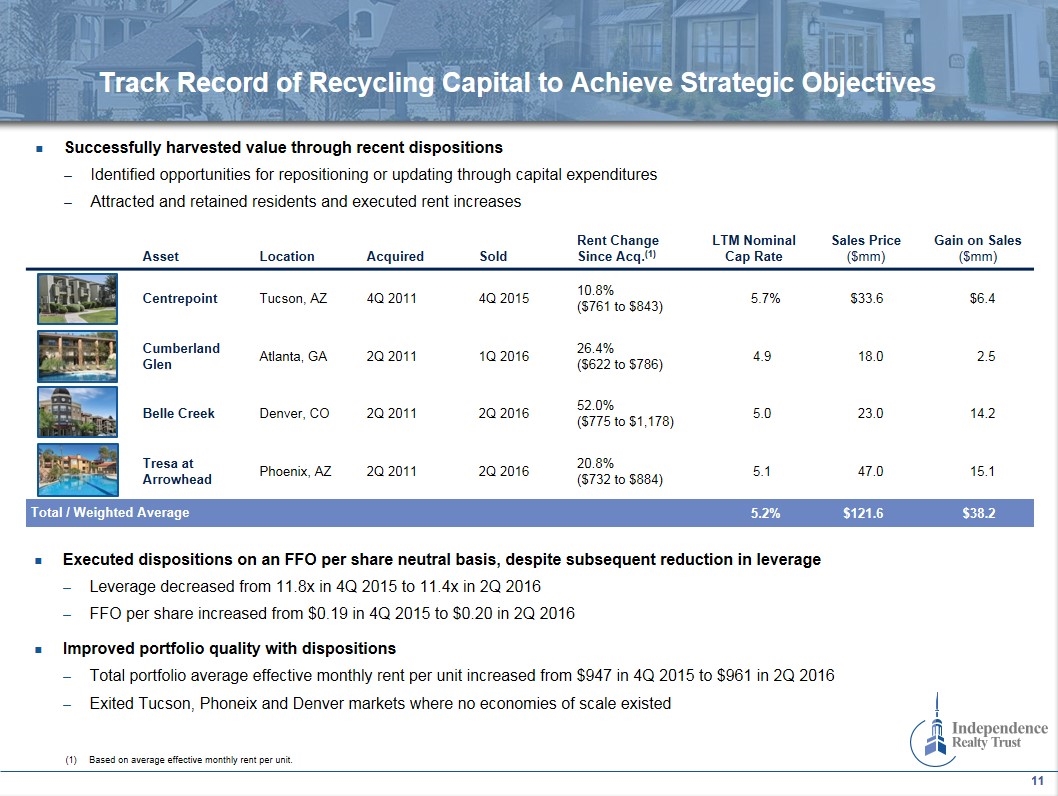
Track Record of Recycling Capital to Achieve Strategic Objectives Successfully harvested value through recent dispositions Identified opportunities for repositioning or updating through capital expenditures Attracted and retained residents and executed rent increases Asset Location Acquired Sold Rent Change Since Acq.(1) LTM Nominal Cap Rate Sales Price ($mm) Gain on Sales ($mm) Centrepoint Tucson, AZ 4Q 2011 4Q 2015 10.8% ($761 to $843) 5.7% $33.6 $6.4 Cumberland Glen Atlanta, GA 2Q 2011 1Q 2016 26.4% ($622 to $786) 4.9 18.0 2.5 Belle Creek Denver, CO 2Q 2011 2Q 2016 52.0% ($775 to $1,178) 5.0 23.0 14.2 Tresa at Arrowhead Phoenix, AZ 2Q 2011 2Q 2016 20.8% ($732 to $884) 5.1 47.0 15.1 Total / Weighted Average 5.2% $121.6 $38.2 Based on average effective monthly rent per unit. Executed dispositions on an FFO per share neutral basis, despite subsequent reduction in leverage Leverage decreased from 11.8x in 4Q 2015 to 11.4x in 2Q 2016 FFO per share increased from $0.19 in 4Q 2015 to $0.20 in 2Q 2016 Improved portfolio quality with dispositions Total portfolio average effective monthly rent per unit increased from $947 in 4Q 2015 to $961 in 2Q 2016 Exited Tucson, Phoneix and Denver markets where no economies of scale existed

2.60 1.80 2.15 3.30 3.75 5.10 0.15 5.10 4.50 - logo 0.15 Highly Attractive Industry and Market Fundamentals
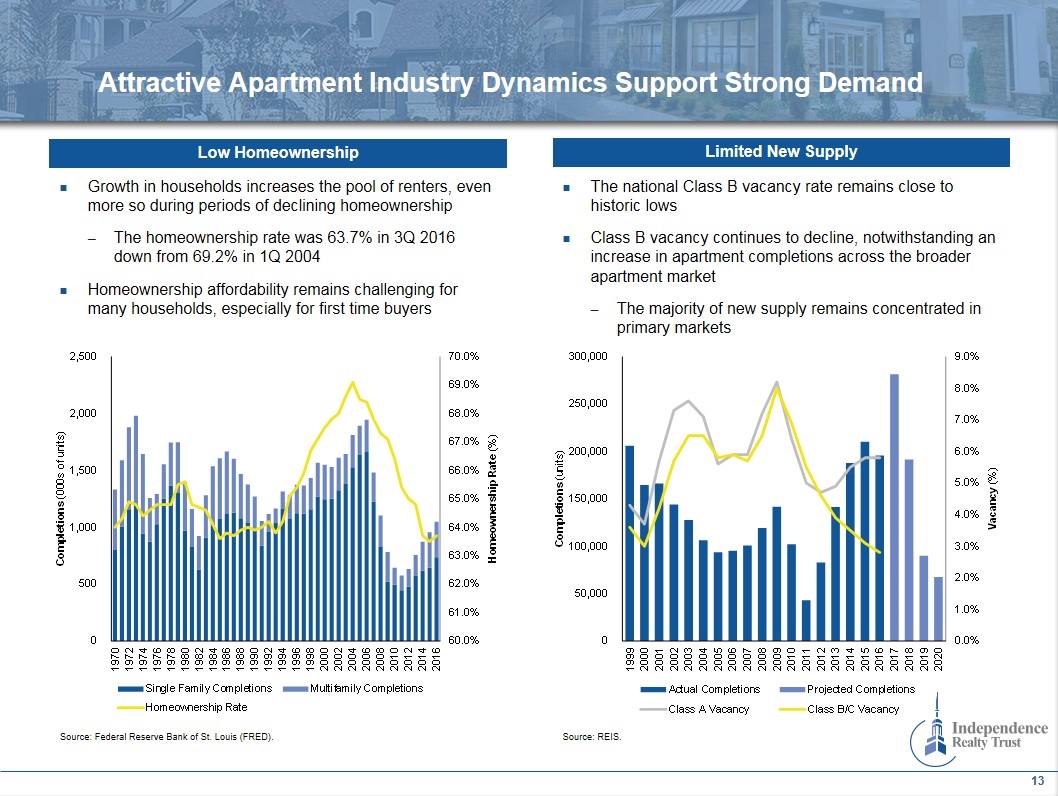
Attractive Apartment Industry Dynamics Support Strong Demand Low Homeownership Limited New Supply Growth in households increases the pool of renters, even more so during periods of declining homeownership The homeownership rate was 63.7% in 3Q 2016 down from 69.2% in 1Q 2004 Homeownership affordability remains challenging for many households, especially for first time buyers The national Class B vacancy rate remains close to historic lows Class B vacancy continues to decline, notwithstanding an increase in apartment completions across the broader apartment market The majority of new supply remains concentrated in primary markets Source: Federal Reserve Bank of St. Louis (FRED). Source: REIS.
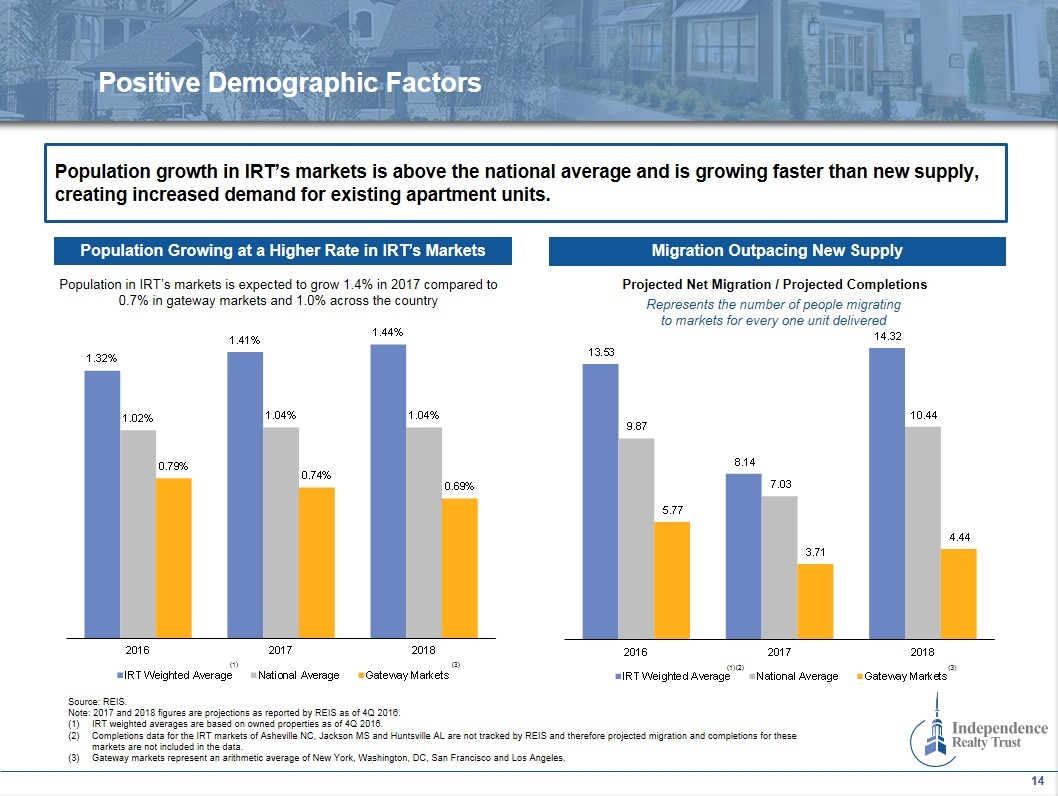
Positive Demographic Factors Population growth in IRT’s markets is above the national average and is growing faster than new supply, creating increased demand for existing apartment units. Migration Outpacing New Supply Projected Net Migration / Projected Completions Population Growing at a Higher Rate in IRT’s Markets Represents the number of people migrating to markets for every one unit delivered Source: REIS. Note: 2017 and 2018 figures are projections as reported by REIS as of 4Q 2016. IRT weighted averages are based on owned properties as of 4Q 2016. Completions data for the IRT markets of Asheville NC, Jackson MS and Huntsville AL are not tracked by REIS and therefore projected migration and completions for these markets are not included in the data. Gateway markets represent an arithmetic average of New York, Washington, DC, San Francisco and Los Angeles. Population in IRT’s markets is expected to grow 1.4% in 2017 compared to 0.7% in gateway markets and 1.0% across the country (1) (3) (1)(2) (3)
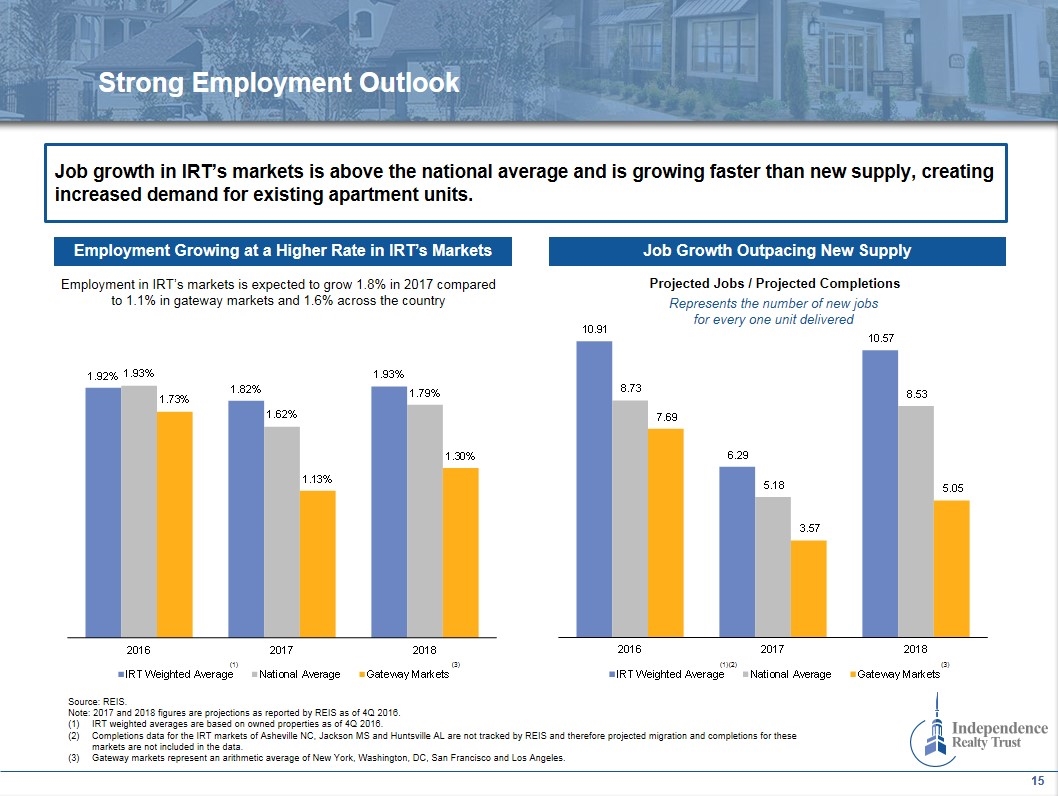
Strong Employment Outlook Job growth in IRT’s markets is above the national average and is growing faster than new supply, creating increased demand for existing apartment units. Job Growth Outpacing New Supply Employment Growing at a Higher Rate in IRT’s Markets Projected Jobs / Projected Completions Represents the number of new jobs for every one unit delivered Employment in IRT’s markets is expected to grow 1.8% in 2017 compared to 1.1% in gateway markets and 1.6% across the country (1) (1)(2) (3) (3) Source: REIS. Note: 2017 and 2018 figures are projections as reported by REIS as of 4Q 2016. IRT weighted averages are based on owned properties as of 4Q 2016. Completions data for the IRT markets of Asheville NC, Jackson MS and Huntsville AL are not tracked by REIS and therefore projected migration and completions for these markets are not included in the data. Gateway markets represent an arithmetic average of New York, Washington, DC, San Francisco and Los Angeles.
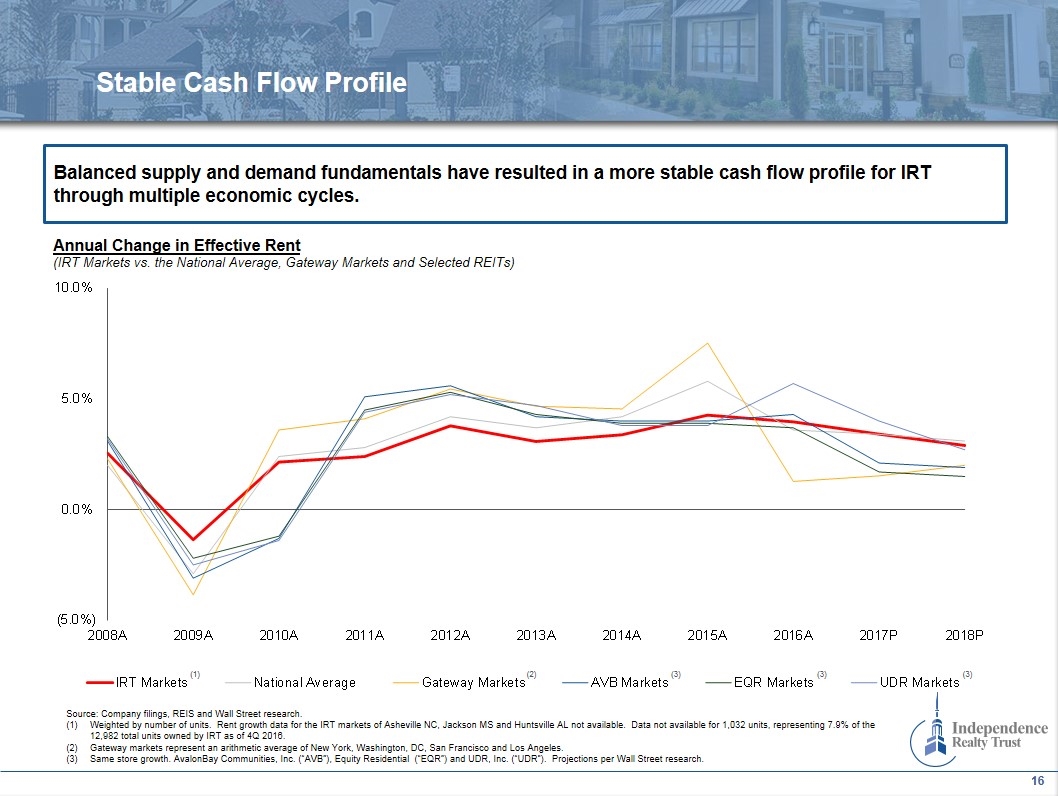
Stable Cash Flow Profile Annual Change in Effective Rent (IRT Markets vs. the National Average, Gateway Markets and Selected REITs) Source: Company filings, REIS and Wall Street research. Weighted by number of units. Rent growth data for the IRT markets of Asheville NC, Jackson MS and Huntsville AL not available. Data not available for 1,032 units, representing 7.9% of the 12,982 total units owned by IRT as of 4Q 2016. Gateway markets represent an arithmetic average of New York, Washington, DC, San Francisco and Los Angeles. Same store growth. AvalonBay Communities, Inc. (“AVB”), Equity Residential (“EQR”) and UDR, Inc. (“UDR”). Projections per Wall Street research. Balanced supply and demand fundamentals have resulted in a more stable cash flow profile for IRT through multiple economic cycles. (1) (3) (3) (3) (2)
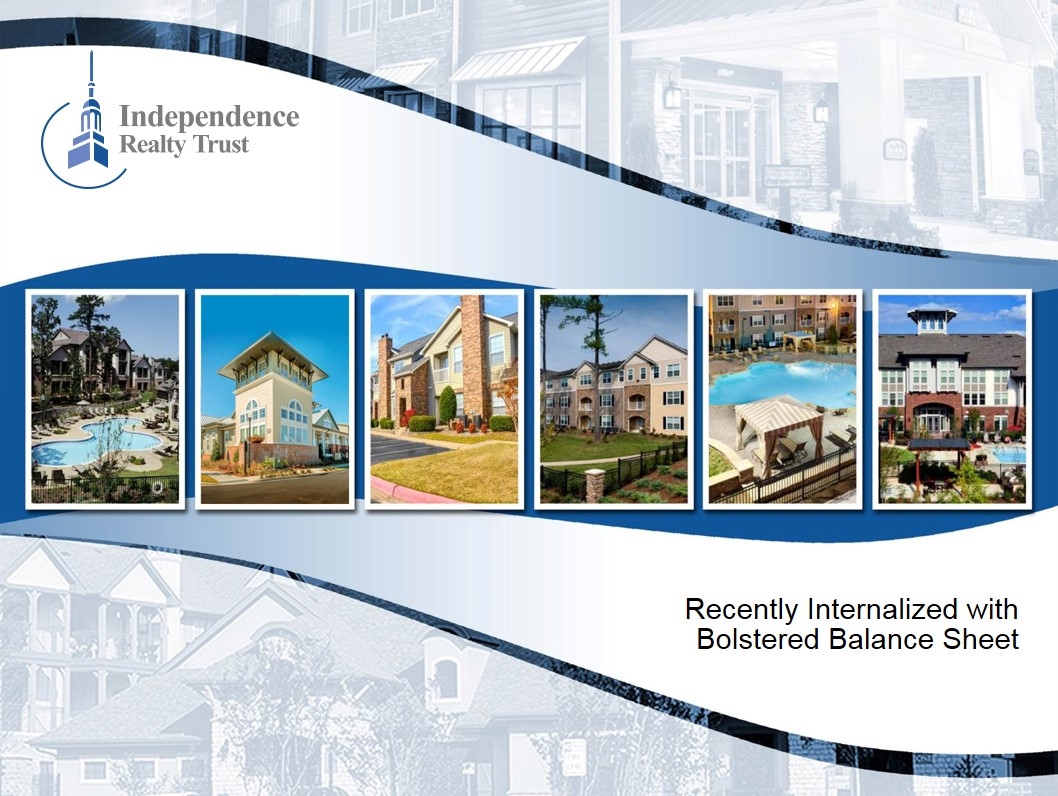
2.60 1.80 2.15 3.30 3.75 5.10 0.15 5.10 4.50 - logo 0.15 Recently Internalized with Bolstered Balance Sheet
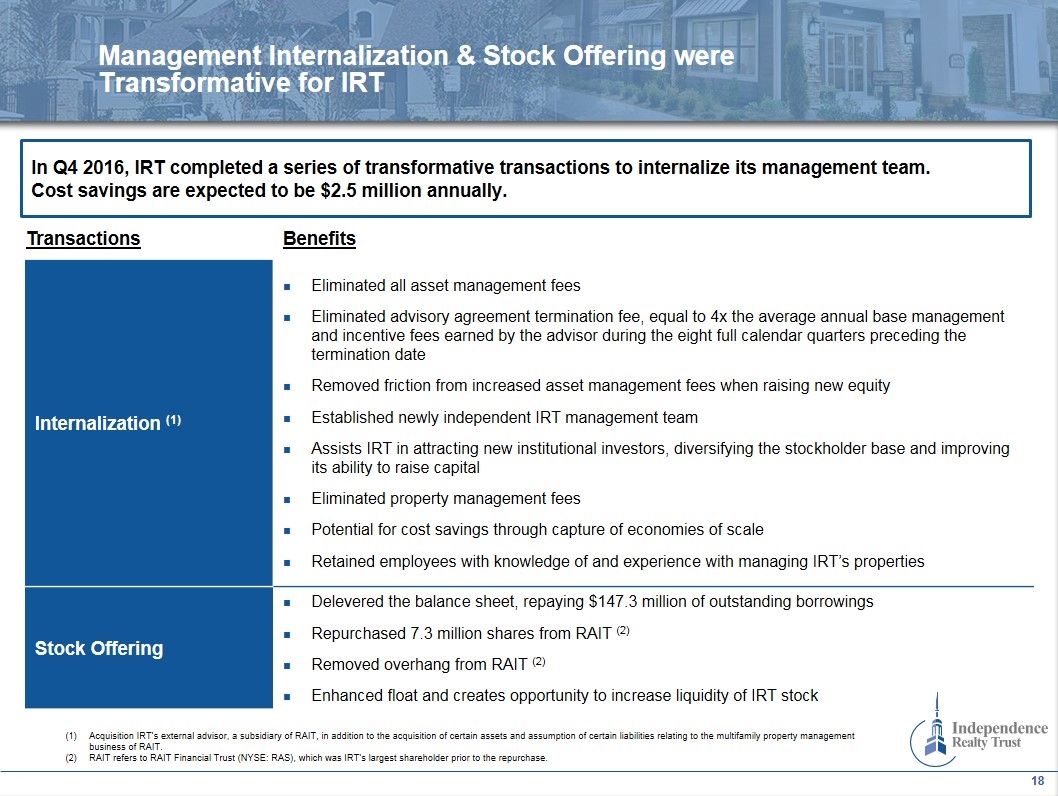
Management Internalization & Stock Offering were Transformative for IRT Internalization (1) Eliminated all asset management fees Eliminated advisory agreement termination fee, equal to 4x the average annual base management and incentive fees earned by the advisor during the eight full calendar quarters preceding the termination date Removed friction from increased asset management fees when raising new equity Established newly independent IRT management team Assists IRT in attracting new institutional investors, diversifying the stockholder base and improving its ability to raise capital Eliminated property management fees Potential for cost savings through capture of economies of scale Retained employees with knowledge of and experience with managing IRT’s properties Stock Offering Delevered the balance sheet, repaying $147.3 million of outstanding borrowings Repurchased 7.3 million shares from RAIT (2) Removed overhang from RAIT (2) Enhanced float and creates opportunity to increase liquidity of IRT stock Acquisition IRT’s external advisor, a subsidiary of RAIT, in addition to the acquisition of certain assets and assumption of certain liabilities relating to the multifamily property management business of RAIT. RAIT refers to RAIT Financial Trust (NYSE: RAS), which was IRT’s largest shareholder prior to the repurchase. Transactions Benefits In Q4 2016, IRT completed a series of transformative transactions to internalize its management team. Cost savings are expected to be $2.5 million annually.
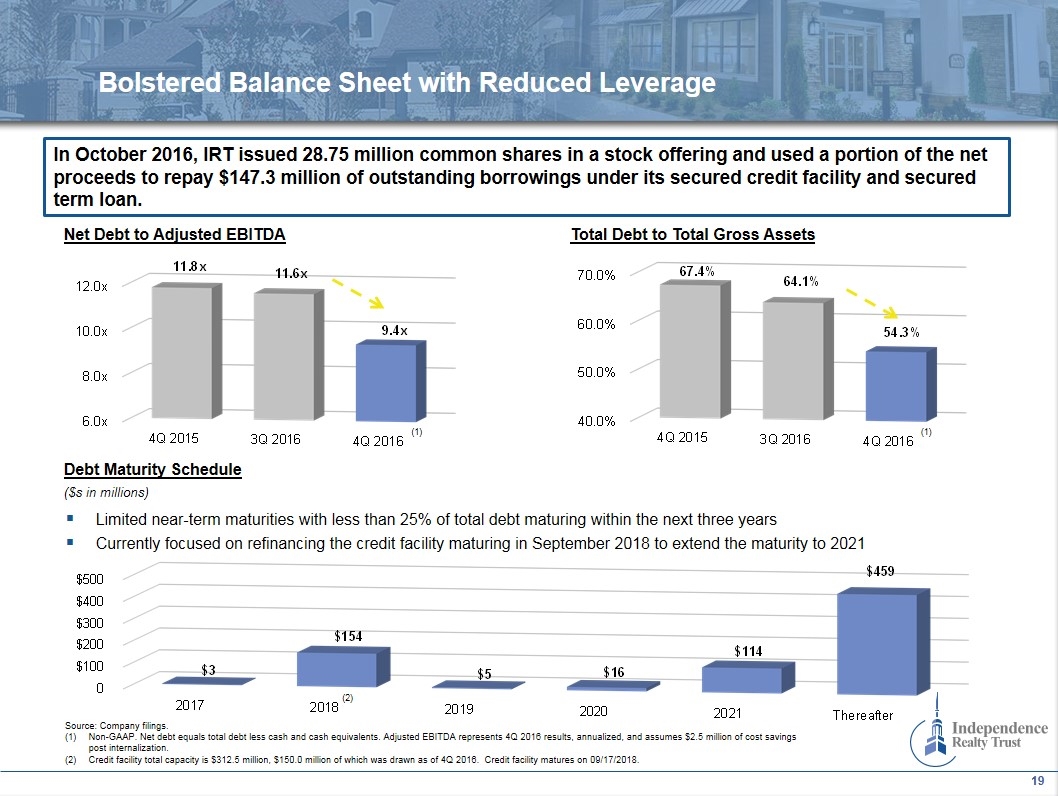
Bolstered Balance Sheet with Reduced Leverage Total Debt to Total Gross Assets Debt Maturity Schedule ($s in millions) Source: Company filings. Non-GAAP. Net debt equals total debt less cash and cash equivalents. Adjusted EBITDA represents 4Q 2016 results, annualized, and assumes $2.5 million of cost savings post internalization. Credit facility total capacity is $312.5 million, $150.0 million of which was drawn as of 4Q 2016. Credit facility matures on 09/17/2018. Net Debt to Adjusted EBITDA (1) (2) (1) Limited near-term maturities with less than 25% of total debt maturing within the next three years Currently focused on refinancing the credit facility maturing in September 2018 to extend the maturity to 2021 In October 2016, IRT issued 28.75 million common shares in a stock offering and used a portion of the net proceeds to repay $147.3 million of outstanding borrowings under its secured credit facility and secured term loan.
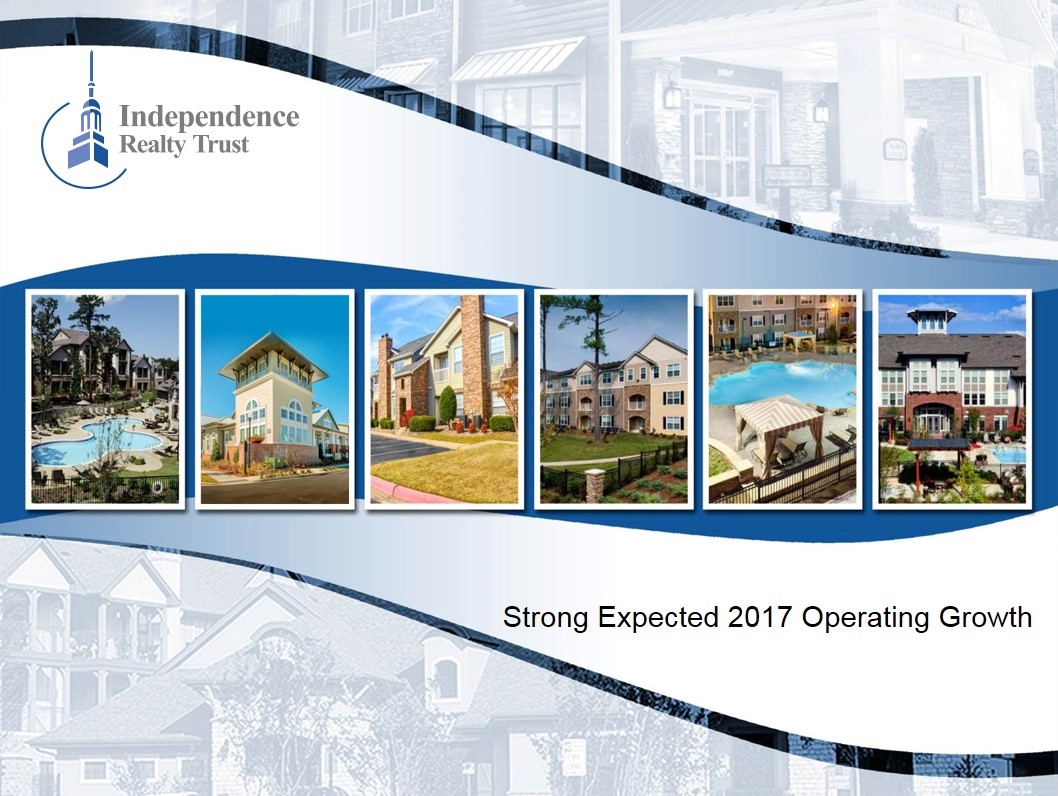
2.60 1.80 2.15 3.30 3.75 5.10 0.15 5.10 4.50 - logo 0.15 Strong Expected 2017 Operating Growth
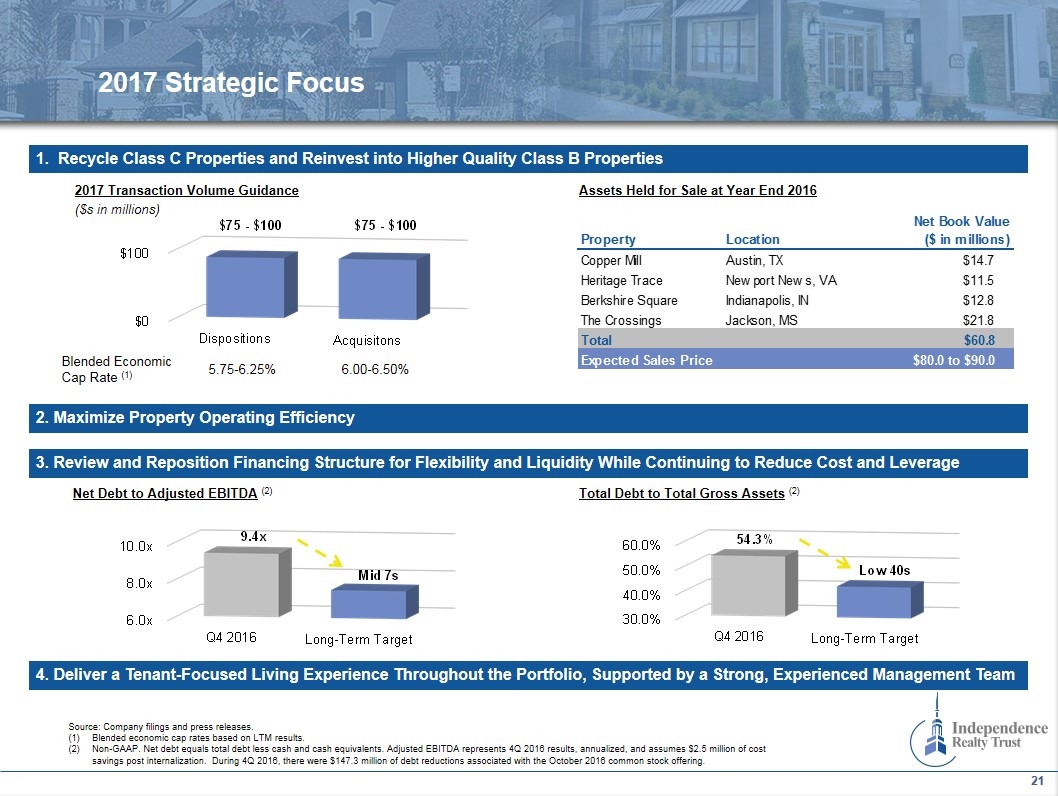
2017 Strategic Focus 1. Recycle Class C Properties and Reinvest into Higher Quality Class B Properties 2. Maximize Property Operating Efficiency 3. Review and Reposition Financing Structure for Flexibility and Liquidity While Continuing to Reduce Cost and Leverage 4. Deliver a Tenant-Focused Living Experience Throughout the Portfolio, Supported by a Strong, Experienced Management Team Source: Company filings and press releases. Blended economic cap rates based on LTM results. Non-GAAP. Net debt equals total debt less cash and cash equivalents. Adjusted EBITDA represents 4Q 2016 results, annualized, and assumes $2.5 million of cost savings post internalization. During 4Q 2016, there were $147.3 million of debt reductions associated with the October 2016 common stock offering. 2017 Transaction Volume Guidance ($s in millions) Assets Held for Sale at Year End 2016 Blended Economic Cap Rate (1) 5.75-6.25% 6.00-6.50% Total Debt to Total Gross Assets (2) Net Debt to Adjusted EBITDA (2)
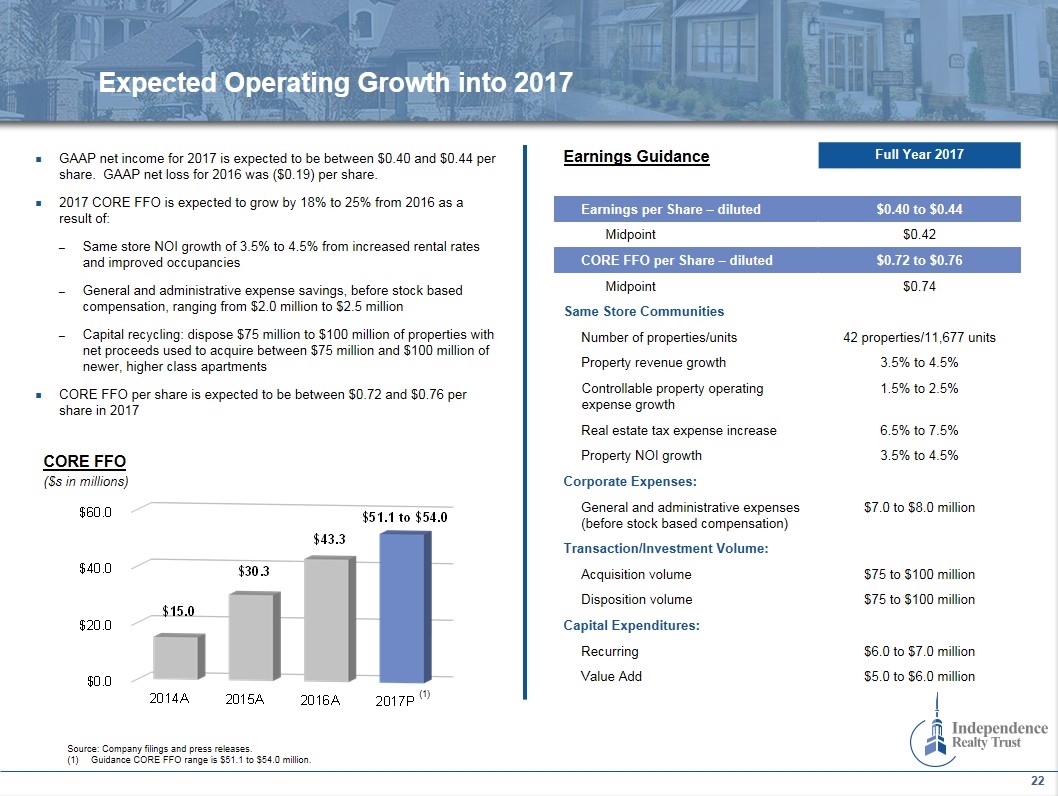
Expected Operating Growth into 2017 GAAP net income for 2017 is expected to be between $0.40 and $0.44 per share. GAAP net loss for 2016 was ($0.19) per share. 2017 CORE FFO is expected to grow by 18% to 25% from 2016 as a result of: Same store NOI growth of 3.5% to 4.5% from increased rental rates and improved occupancies General and administrative expense savings, before stock based compensation, ranging from $2.0 million to $2.5 million Capital recycling: dispose $75 million to $100 million of properties with net proceeds used to acquire between $75 million and $100 million of newer, higher class apartments CORE FFO per share is expected to be between $0.72 and $0.76 per share in 2017 Source: Company filings and press releases. Guidance CORE FFO range is $51.1 to $54.0 million. CORE FFO ($s in millions) (1) Earnings Guidance Full Year 2017 Earnings per Share – diluted $0.40 to $0.44 Midpoint $0.42 CORE FFO per Share – diluted $0.72 to $0.76 Midpoint $0.74 Same Store Communities Number of properties/units 42 properties/11,677 units Property revenue growth 3.5% to 4.5% Controllable property operating expense growth 1.5% to 2.5% Real estate tax expense increase 6.5% to 7.5% Property NOI growth 3.5% to 4.5% Corporate Expenses: General and administrative expenses (before stock based compensation) $7.0 to $8.0 million Transaction/Investment Volume: Acquisition volume $75 to $100 million Disposition volume $75 to $100 million Capital Expenditures: Recurring $6.0 to $7.0 million Value Add $5.0 to $6.0 million
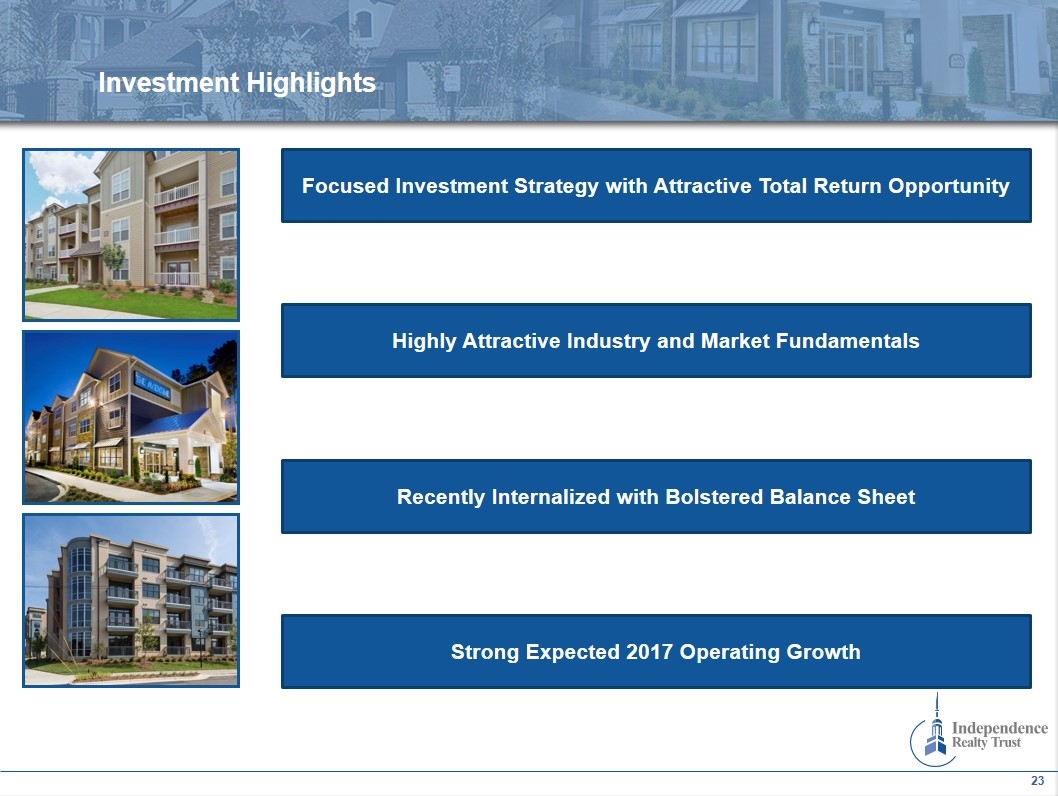
Recently Internalized with Bolstered Balance Sheet Focused Investment Strategy with Attractive Total Return Opportunity Strong Expected 2017 Operating Growth Investment Highlights Highly Attractive Industry and Market Fundamentals

2.60 1.80 2.15 3.30 3.75 5.10 0.15 5.10 4.50 - logo 0.15 Appendix
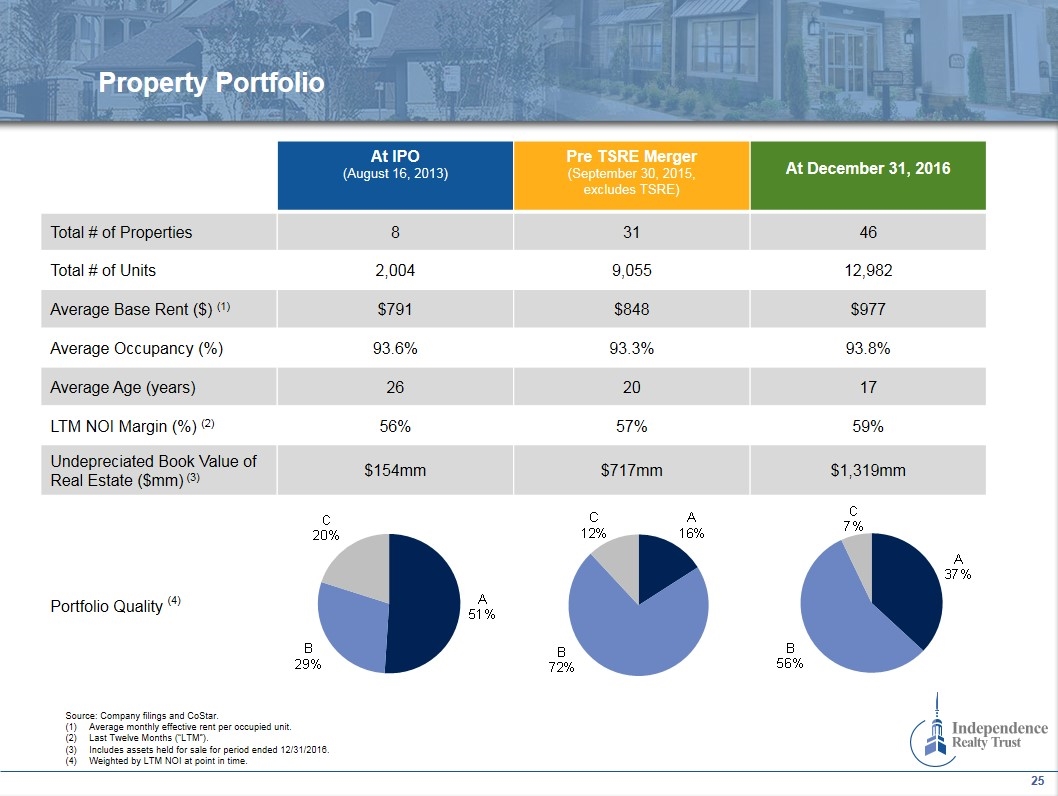
Property Portfolio At IPO (August 16, 2013) Pre TSRE Merger (September 30, 2015, excludes TSRE) At December 31, 2016 Total # of Properties 8 31 46 Total # of Units 2,004 9,055 12,982 Average Base Rent ($) (1) $791 $848 $977 Average Occupancy (%) 93.6% 93.3% 93.8% Average Age (years) 26 20 17 LTM NOI Margin (%) (2) 56% 57% 59% Undepreciated Book Value of Real Estate ($mm) (3) $154mm $717mm $1,319mm Portfolio Quality (4) Source: Company filings and CoStar. Average monthly effective rent per occupied unit. Last Twelve Months (“LTM”). Includes assets held for sale for period ended 12/31/2016. Weighted by LTM NOI at point in time.
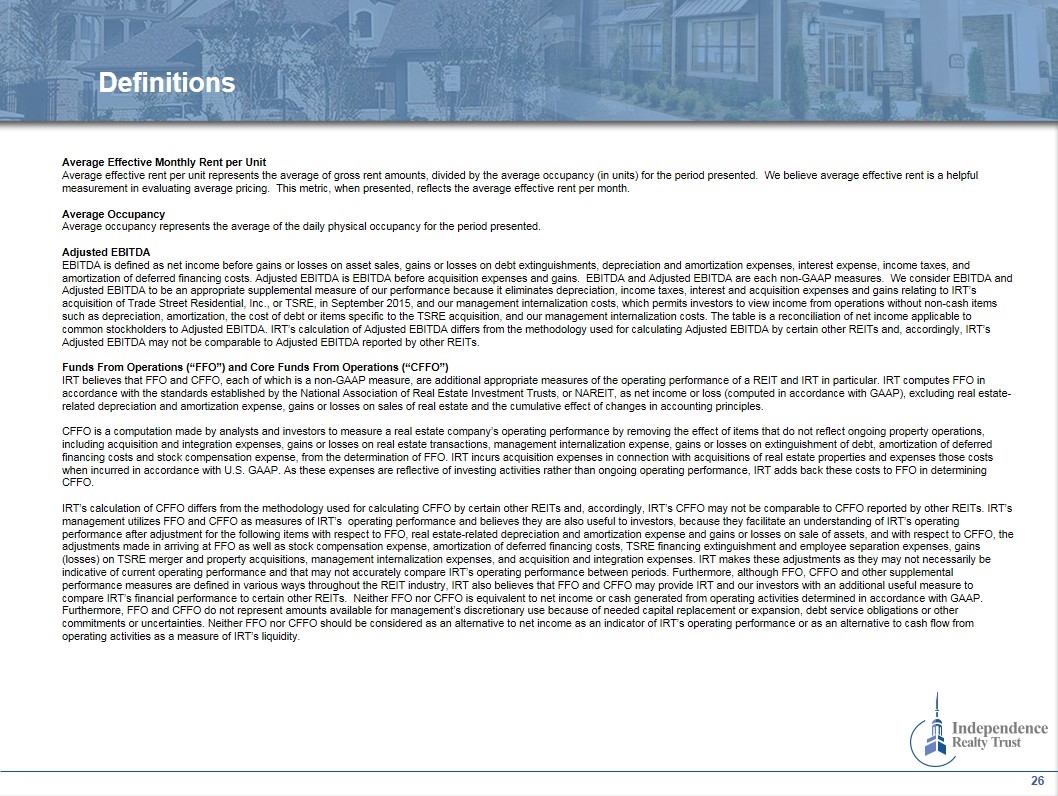
Definitions Average Effective Monthly Rent per Unit Average effective rent per unit represents the average of gross rent amounts, divided by the average occupancy (in units) for the period presented. We believe average effective rent is a helpful measurement in evaluating average pricing. This metric, when presented, reflects the average effective rent per month. Average Occupancy Average occupancy represents the average of the daily physical occupancy for the period presented. Adjusted EBITDA EBITDA is defined as net income before gains or losses on asset sales, gains or losses on debt extinguishments, depreciation and amortization expenses, interest expense, income taxes, and amortization of deferred financing costs. Adjusted EBITDA is EBITDA before acquisition expenses and gains. EBITDA and Adjusted EBITDA are each non-GAAP measures. We consider EBITDA and Adjusted EBITDA to be an appropriate supplemental measure of our performance because it eliminates depreciation, income taxes, interest and acquisition expenses and gains relating to IRT’s acquisition of Trade Street Residential, Inc., or TSRE, in September 2015, and our management internalization costs, which permits investors to view income from operations without non-cash items such as depreciation, amortization, the cost of debt or items specific to the TSRE acquisition, and our management internalization costs. The table is a reconciliation of net income applicable to common stockholders to Adjusted EBITDA. IRT’s calculation of Adjusted EBITDA differs from the methodology used for calculating Adjusted EBITDA by certain other REITs and, accordingly, IRT’s Adjusted EBITDA may not be comparable to Adjusted EBITDA reported by other REITs. Funds From Operations (“FFO”) and Core Funds From Operations (“CFFO”) IRT believes that FFO and CFFO, each of which is a non-GAAP measure, are additional appropriate measures of the operating performance of a REIT and IRT in particular. IRT computes FFO in accordance with the standards established by the National Association of Real Estate Investment Trusts, or NAREIT, as net income or loss (computed in accordance with GAAP), excluding real estate-related depreciation and amortization expense, gains or losses on sales of real estate and the cumulative effect of changes in accounting principles. CFFO is a computation made by analysts and investors to measure a real estate company’s operating performance by removing the effect of items that do not reflect ongoing property operations, including acquisition and integration expenses, gains or losses on real estate transactions, management internalization expense, gains or losses on extinguishment of debt, amortization of deferred financing costs and stock compensation expense, from the determination of FFO. IRT incurs acquisition expenses in connection with acquisitions of real estate properties and expenses those costs when incurred in accordance with U.S. GAAP. As these expenses are reflective of investing activities rather than ongoing operating performance, IRT adds back these costs to FFO in determining CFFO. IRT’s calculation of CFFO differs from the methodology used for calculating CFFO by certain other REITs and, accordingly, IRT’s CFFO may not be comparable to CFFO reported by other REITs. IRT’s management utilizes FFO and CFFO as measures of IRT’s operating performance and believes they are also useful to investors, because they facilitate an understanding of IRT’s operating performance after adjustment for the following items with respect to FFO, real estate-related depreciation and amortization expense and gains or losses on sale of assets, and with respect to CFFO, the adjustments made in arriving at FFO as well as stock compensation expense, amortization of deferred financing costs, TSRE financing extinguishment and employee separation expenses, gains (losses) on TSRE merger and property acquisitions, management internalization expenses, and acquisition and integration expenses. IRT makes these adjustments as they may not necessarily be indicative of current operating performance and that may not accurately compare IRT’s operating performance between periods. Furthermore, although FFO, CFFO and other supplemental performance measures are defined in various ways throughout the REIT industry, IRT also believes that FFO and CFFO may provide IRT and our investors with an additional useful measure to compare IRT’s financial performance to certain other REITs. Neither FFO nor CFFO is equivalent to net income or cash generated from operating activities determined in accordance with GAAP. Furthermore, FFO and CFFO do not represent amounts available for management’s discretionary use because of needed capital replacement or expansion, debt service obligations or other commitments or uncertainties. Neither FFO nor CFFO should be considered as an alternative to net income as an indicator of IRT’s operating performance or as an alternative to cash flow from operating activities as a measure of IRT’s liquidity.
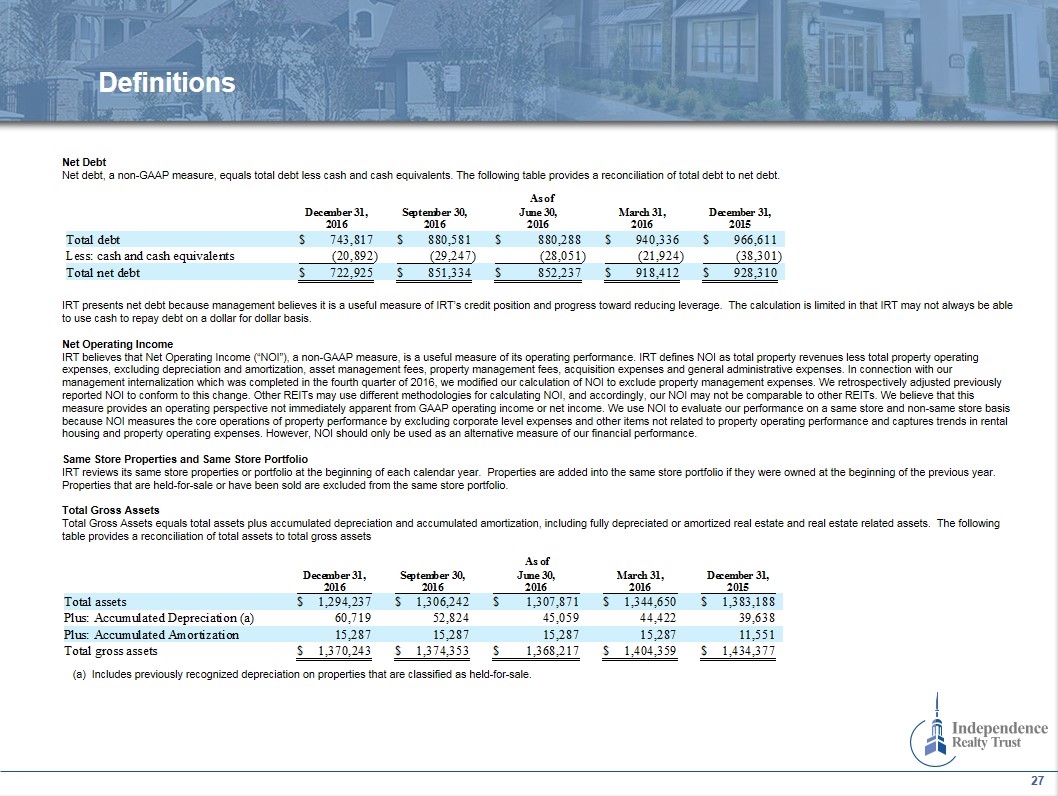
Definitions Net Debt Net debt, a non-GAAP measure, equals total debt less cash and cash equivalents. The following table provides a reconciliation of total debt to net debt. IRT presents net debt because management believes it is a useful measure of IRT’s credit position and progress toward reducing leverage. The calculation is limited in that IRT may not always be able to use cash to repay debt on a dollar for dollar basis. Net Operating Income IRT believes that Net Operating Income (“NOI”), a non-GAAP measure, is a useful measure of its operating performance. IRT defines NOI as total property revenues less total property operating expenses, excluding depreciation and amortization, asset management fees, property management fees, acquisition expenses and general administrative expenses. In connection with our management internalization which was completed in the fourth quarter of 2016, we modified our calculation of NOI to exclude property management expenses. We retrospectively adjusted previously reported NOI to conform to this change. Other REITs may use different methodologies for calculating NOI, and accordingly, our NOI may not be comparable to other REITs. We believe that this measure provides an operating perspective not immediately apparent from GAAP operating income or net income. We use NOI to evaluate our performance on a same store and non-same store basis because NOI measures the core operations of property performance by excluding corporate level expenses and other items not related to property operating performance and captures trends in rental housing and property operating expenses. However, NOI should only be used as an alternative measure of our financial performance. Same Store Properties and Same Store Portfolio IRT reviews its same store properties or portfolio at the beginning of each calendar year. Properties are added into the same store portfolio if they were owned at the beginning of the previous year. Properties that are held-for-sale or have been sold are excluded from the same store portfolio. Total Gross Assets Total Gross Assets equals total assets plus accumulated depreciation and accumulated amortization, including fully depreciated or amortized real estate and real estate related assets. The following table provides a reconciliation of total assets to total gross assets (a) Includes previously recognized depreciation on properties that are classified as held-for-sale.


























